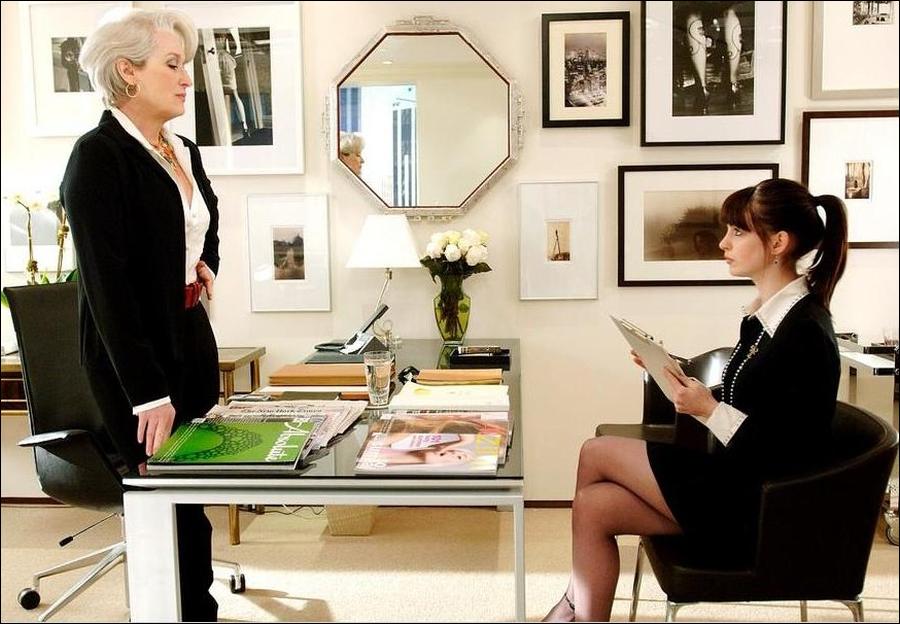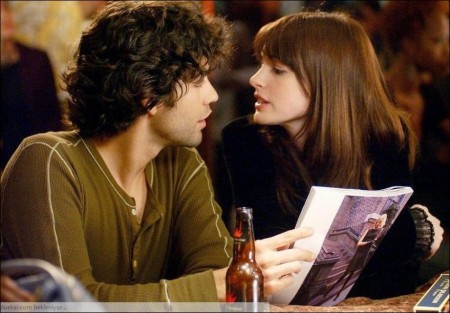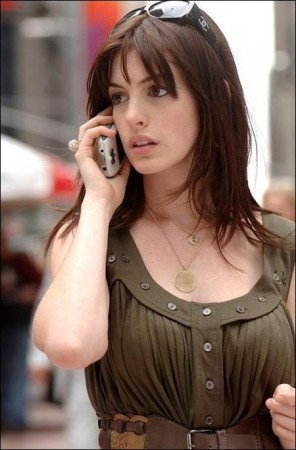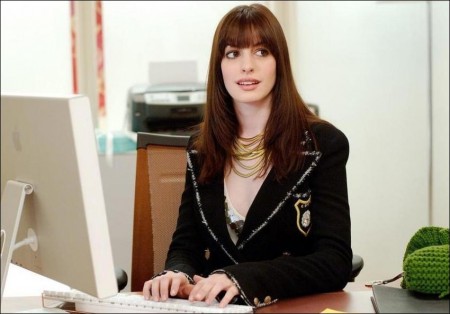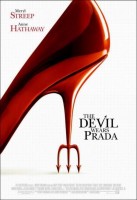Based on the best-selling novel, “The Devil Wears Prada” stars two-time Academy Award winner Meryl Streep as high-powered fashion magazine editor Miranda Priestly, and Anne Hathaway, as Miranda’s new assistant – a small-town girl trying to survive her impossibly demanding new boss.
In the dizzying world of New York fashion, where size zero is the new 2, six is the new 8, and a bad hair day can end a career, Runway Magazine is the Holy Grail. Overseen with a finely manicured fist by Miranda Priestly (Meryl Streep) – the most powerful woman in fashion – Runway is a fearsome gauntlet for anyone who wants to make it in the industry. To make Runway the fashion bible of New York and therefore the world, Miranda has let nothing stand in her way… including assistants that didn’t make the cut. It’s a job no self-respecting person can survive, yet it’s an opportunity a million young women in New York would kill for.
A stint as Miranda’s assistant could blast-open the doors for recent college graduate Andy Sachs (Anne Hathaway). More college drab than haute couture, she stands alone among the small army of “Clackers” on staff at Runway – superslim fashion divas clacking their stilettos down the halls of the magazine’s Manhattan headquarters. But when Andy comes in for the job, it dawns on her that making it in this industry will take more than drive and determination. And her ultimate test stands before her in head-to-toe Prada.
Miranda can spin the fashion world like a basketball but has a devil of a time finding and keeping a good assistant. Andy is completely wrong for the job. But she has something the rest of them don’t: she refuses to fail.
To become the perfect assistant, Andy will need to make herself over in Miranda’s image. Soon, much to her boyfriend’s (Adrian Grenier) dismay, she can talk the talk, walk the walk (in flawless Manolo’s) and never again confuse Dolce with Gabbana.
But the more of life she sees through Miranda’s eyes, the more she begins to grasp that Miranda’s world is a fabulous but lonely one – and that sometimes great success depends on great sacrifice … but at what cost?
THE DEVIL WEARS PRADA is based on the internationally best-selling novel by Lauren Weisberger, which spent six months on The New York Times bestseller list and was translated into 27 languages.
In the film, two-time Oscar winner Meryl Streep is Miranda Priestly, the reigning queen of fashion whose whims can start and end careers.
About the Production
In the dizzying world of New York fashion, where size zero is the new 2, six is the new 8, and a bad hair day can end a career, Runway Magazine is the Holy Grail. Overseen with a finely manicured fist by Miranda Priestly (Meryl Streep) — the most powerful woman in fashion — Runway is a fearsome gauntlet for anyone who wants to make it in the industry. To make Runway the fashion bible of New York and therefore the world, Miranda has let nothing stand in her way… including a long line of assistants that didn’t make the cut. It’s a job no self-respecting person can survive, yet it’s an opportunity a million young women in New York would kill for.
A stint as Miranda’s assistant could blast-open the doors for recent college graduate Andy Sachs (Anne Hathaway). More college drab than haute couture, she stands alone among the small army of “Clackers” on staff at Runway — superslim fashion divas clacking their stilettos down the halls of the magazine’s Manhattan headquarters. But when Andy comes in for the job, it dawns on her that making it in this industry will take more than drive and determination. And her ultimate test stands before her in head-to-toe Prada.
Miranda can spin the fashion world like a basketball but has a devil of a time finding and keeping a good assistant. Andy is completely wrong for the job. But she has something the rest of them don’t: she refuses to fail To become the perfect assistant, Andy will need to make herself over in Miranda’s image. Soon, much to her boyfriend’s (Adrian Grenier) dismay, she can talk the talk, walk the walk (in flawless Manolo’s) and never again confuse Dolce with Gabbana. But the more of life she sees through Miranda’s eyes, the more she begins to grasp that Miranda’s world is a fabulous but lonely one — and that sometimes great success depends on great sacrifice… but at what cost?
The Devil Wears Prada is based on the internationally best-selling novel by Lauren Weisberger, which spent six months on The New York Times bestseller list and was translated into 27 languages. In the film, two-time Oscar winner Meryl Streep is Miranda Priestly, the reigning queen of fashion whose whims can start and end careers.
Director David Frankel, who explored the vagaries of fashion and celebrity in the landmark series “Sex in the City” and “Entourage,” says that instead of making the choice to demonize Miranda, he preferred “to explore Miranda’s relentless pursuit of excellence in a serious way,” he says. “And how many sacrifices she must make to excel.
“There are lots of famous women who are successful on the level of Miranda Priestly, and it is very easy to criticize them because they put their work first,” Frankel continues. “Men are rarely criticized for that.”
Miranda has made hard sacrifices to make it to the top and stay there. Love her or hate her (with most underlings falling into the “hate” category), no one can deny she is the primary architect of a formidable empire. “Miranda has an incredible amount of power in the marketplace,” says Meryl Streep. “She’s a taste- and trend-maker and therefore a market-setter. She functions with a lot of pressure, and she runs a very tight ship.”
Streep’s Miranda, Frankel points out, skates the edge between the comically mean and the genuinely sad. “A key part of Meryl’s incredible talent is the ability to blend comedy and drama,” he says. “She can find what’s funny in the real so that it never feels forced.”
Streep plunged headlong into all the accoutrements that surround Miranda. “When we first met her I gave her a huge three-ringed binder full of research regarding the movie and fashion,” recalls producer Wendy Finerman. “It included fashion industry facts, figures, and photos, and I thought, `Oh God, she’s going to laugh at me.’ But instead she said, `That’s fantastic! Do you have any more?’ She read everything she could get her hands on. It was just amazing.”
Finding a good assistant who can live up to Miranda’s high expectations is a near impossible task. That changes when the smart, unfashionable Andy Sachs walks into her office.
Anne Hathaway, the breakout star of “The Princess Diaries,” and who had a key role in “Brokeback Mountain,” portrays Andy, a journalism student who believes she can change the world after leaving the comforts of Northwestern University and landing in the big city.
Andy, says Frankel, “is on a journey that we all take when we get our first jobs and discover what the real world is like. We’re faced with ethical and moral choices that we never considered, and we learn about ourselves.” Hathaway adds, “If you’re over age 21, you’ve probably had some of Andy’s experiences.”
In the distorted aesthetics of the New York fashion scene, a size 6 like Andy stands out. “She is a beautiful girl who is not model-thin, which is an important distinction for this character,” says Frankel. Hathaway embodied Andy with grace and humor. “Anne is funny and will do things in a way that not a lot of actors could do,” Finerman adds, “and every time she does so, it is fresh and new. She finds the funny and never holds back.
Andy interviews with a New York publishing giant, hoping to secure a junior writing position at one of its prestige publications. The only two openings, however, are at Auto Universe — or as Miranda Priestly’s assistant. With her impressive resume in hand, Andy braves the halls of Runway, a magazine she never reads, weaving through a sea of Clackers.
Andy’s first moments with Miranda are a soul-crushing disaster. Judged simply by her cotton blend sweater and shapeless skirt, Andy is dismissed with a wave of Miranda’s hand. But Andy doesn’t take no for an answer. She may not be the best-dressed girl in the room, but she’s smart and she’ll work hard. This makes an impression on a woman to whom no one dares even ask a question, let alone contradict.
“When Miranda first meets Andy,” says Streep, “it’s at the end of a series of disappointments she’s had with other assistants. Andy comes in with an amazing resume, and Miranda takes a chance on her because she doesn’t fit the mold of the typical Runway employee.” For once, Miranda, known for her unpredictability, hires the “smart, fat girl” instead of the “stylish, slender, disappointing” type that usually trails after her.
But at the moment of Andy’s first big assignment — bringing Miranda home from hurricane-struck Miami so she can catch her twins’ recital — Andy blows it. Her failure is so great she questions her motives for taking the position.
Stanley Tucci (“The Terminal,” “Big Night”) stars as Miranda’s right-hand man Nigel, who like everyone at Runway, survives on Miranda’s whim. Nigel is horrified when he meets Andy for the first time, because her hair, clothes and shoes — well, they’re just all wrong. “To say he is a snob would be quite the understatement,” Tucci says, but Nigel and Andy become friends. “This very bitchy fellow turns out to be a softy in the end.”
“Nigel is very funny,” adds Streep, “and just one of those people who can say anything to Miranda. So they are friends, but Miranda is always his boss, and that makes their relationship really tricky.”
Nigel understands what makes Miranda tick. “She’s one tough cookie,” Tucci says. “She’s a workaholic and someone who wields a tremendous amount of power and knows it. Everyone who works for her is at her beck and call so she’s not the kind of person you’d want to come on the wrong side of.”
With Nigel’s help, Andy squeezes into a size-four Chanel from the Runway wardrobe room. A sleek new haircut, some stiletto Jimmy Choos and suddenly Andy is indistinguishable from the rest of the Clackers at Runway, and becomes the best assistant Miranda ever had. “How do you know you’re doing well working for Miranda?” Nigel asks. “Your personal life falls apart. When your whole life goes up in smoke, that’s when it’s time for a promotion.”
“Andy begins as a strong, grounded character, and as the story progresses, she becomes more and more preoccupied with success,” says Hathaway. “All she can see is her job and doing it well. When you’ve imagined that you’re going to save the world, and you find that the world isn’t always willing to be saved, you need to rethink who you are.”
When she first falls under Miranda’s control, Andy sees her boss as “a career-obsessed dragon lady,” says Hathaway. “Miranda is cold, has no feelings and only focuses on one thing: her job.” But as time and her experience in Miranda’s world open her eyes, Andy begins to see her boss in a new light. “Andy learns from Miranda the relentless pursuit of journalism excellence,” Hathaway says. “She teaches her what it takes to be the best.”
Andy makes a reluctant friend in Miranda’s chief assistant Emily, played by British actress Emily Blunt (“My Summer of Love”). “Emily is so far on the edge of fashion that she’s practically falling off,” Blunt says. “She has no friends and thinks of nothing else but Miranda.”
Streep adds, “Emily doesn’t want to be anything other than what she is and how she functions, but she wants to be the very best at her job that she can possibly be, and so she’s very very disapproving of Andy. Emily is smacked around by Miranda, and she likes to punish Andy in kind.”
Unlike Emily, Andy discovers her personal limits in this non-stop, take-no-prisoners world. Andy’s boyfriend Nate (Adrian Grenier) is a constant reminder that her new position doesn’t always gibe with her values. “He is not seduced by fashion and style and money and power,” says Grenier, the charismatic star of the popular HBO series “Entourage.”
“As Andy becomes seduced by Miranda’s world, Nate is there to remind her where she came from,” Frankel adds. “Nate doesn’t find it difficult to hold on to his integrity.”
Though THE DEVIL WEARS PRADA is set in the rarefied world of fashion, Andy’s journey with Miranda is universal in its theme of a young person finding her way. “What happens to Andy is very character-forming,” Hathaway says. “As she changes, she realizes it’s important to commit not necessarily to success, but to succeed on your own terms.”
A film about fashion and publishing could be shot nowhere but New York itself, the beating heart of the high fashion and publishing industries. “New York is the fashion capital of the world,” Frankel says. “There isn’t a city that is more fun or sexier than New York. You can’t take a step without finding a great location. There is a history, a depth, a twinkliness.”
“For Andy’s story to be real, you need the real world,” says Wendy Finerman. “You’ve got to be fighting on the subway and going across town while everybody else is going in the other direction. Then there is New York’s romance and youthfulness; there are so many young people seeing the city for the first time, waiting to experience the world as an adult.”
Andy is one of these young people, seeking to begin her life as an adult in the Big Apple. “Andy is full of excitement when she first moves to New York,” Frankel says. “She must quickly learn the city’s ins and outs in order to complete seemingly impossible tasks for Miranda. Any visitor to New York remembers the first time discovering the city. Like Miranda, New York is intimidating and it requires time and effort to understand how to function there.”
Production designer Jess Gonchor created two contrasting worlds: Andy and Nate’s simple home, and the ever-fabulous but treacherous orbit of Miranda Priestly. Runway’s offices had to express Miranda’s taste and insistence upon elegance and perfection. “The offices had to be very feminine and homey, and have a light color palette,” Gonchor explains.
Streep and Gonchor together selected the artwork showcased in Miranda’s offices. “It was important to show photographs that Miranda had `collected’ and great works of art because she’s all about the pursuit of excellence, no matter the cost,” Frankel says.
In these suites, there is no question who is in charge. “There is not much separating Miranda from the rest of the office,” Gonchor says. “She can always see who is coming and going.”
Miranda keeps an eagle eye on her assistants, often confronting them with no warning. “David [Frankel] was adamant about that,” says Gonchor. “Her staff is tucked away far enough that they don’t see her coming.”
The Runway interiors — including Miranda’s office, the conference room, and the bull pen — were meticulously designed to express perfection, with lots of glass and exact angles. Gonchor, Frankel and Finerman pored over fashion and architectural magazines, as well as layouts and blueprints of comparable real-life offices, to hit the right authentic design notes. “We put together a model and then took a look at it with a little lipstick camera to see what the angles were,” Gonchor says. “We decided on what the footprint should look like and started building. It took three months to build it, wallpaper it, paint it and dress it.”
Andy’s apartment has none of the clean lines and expensive pieces of art that adorn Miranda’s office. Andy’s apartment is “furnished with stuff from flea markets, things I had in storage,” Gonchor describes. “Nothing matches. We aged down the walls quite a bit so the apartment had a down tone to it.”
THE DEVIL WEARS PRADA comes at a time of heightened interest in the runway scene. “Fashion is a universal interest now,” says producer Wendy Finerman. “The new collections from Paris are seen on the Internet within hours of their unveiling. Then they’re copied and knocked off around the world.”
Fashion, says director David Frankel, is “a constant pursuit for reinvention. It’s both what’s so great and what’s so awful about fashion. For fashion to succeed, it has to make all of us feel that everything we have and wear is inadequate.”
“People love fashion,” Streep says. “They love to look at it, in magazines, in runway shots… everything. But it’s interesting to get a look inside this world, and see how much of a business it is, and where the fun is and where the fun stops.”
Those in the business have few illusions about what they do. “Fashion Fabulousness” takes work and having a place at the cutting edge of trends requires not only vision but great ambition. “The movie doesn’t have a judgment about the fashion world,” says screenwriter Aline Brosh McKenna, who adapted Lauren Weisberger’s best-selling novel. “We take the fashion seriously as a business and show it realistically.”
For the film to create a realistic portrait of today’s fashion giants, the costumes had to be authentic. “The way I made sure that we got the fashion right was to hire Patricia Field as our costume designer,” Frankel says. Field, an Emmy® winner for her work on “Sex and the City,” created a style for Streep’s Miranda Priestly, as well as for Anne Hathaway’s character’s transformation into a fashionista, and the look of the omnipresent “Clackers.”
Miranda’s look had to stand on its own; no one else could look like her. Meryl Streep herself influenced aspects of Miranda’s wardrobe. Field set out to dress “the leading fashion editor of the world — to create Miranda’s look with Meryl. My job was to make Meryl look as absolutely beautiful as I could. Not to dictate fashion, but to have people say, `Wow, Meryl Streep!'”
Legendary designer Valentino designed a dress Miranda wears at a ritzy charity ball. “Valentino created this dress for Meryl and in the end, it was the dress that she looked sexiest in,” Field states. “It’s very simple and shows her beautiful shoulders, her porcelain skin, and her curves.”
Valentino also makes his acting debut in the film. “I’m such a great admirer of Ms. Streep,” he says. “Just to have a little cameo with her, for me, is a great honor.”
“Valentino was really a wonderful casting coup,” Finerman says. “He is truly an icon. Having him in our film is an incredible opportunity because he’s a face people know.
“The dresses for the gala were outrageous,” Finerman continues, “and they’re meant to be outrageous, of course. Everyone looked like they were going to a high society event, down to every last extra. Pat dressed everyone to the nines.”
Frankel first collaborated with Field on the feature film “Miami Rhapsody,” where her creative talent made a lasting impression on the director. “Pat had Sarah Jessica Parker wear certain things and I’d say, `What is that?’ Then two years later it would be everywhere. So I learned to trust her instincts. Pat is brilliant at seeing into the future of fashion, anticipating and making trends.”
“Pat provided an authentic backdrop of fashion,” Finerman says. “She was able to get us so many clothes for which we didn’t have a budget. Chanel provided its 2006 couture collection to the production, exclusively. Field also magically produced designs from Valentino, Donna Karan, Bill Blass, Galliano, and, of course, Prada.
The cast was thrilled to work with Field, who functions as a fashion designer as well as a costume designer on her film projects. “The fact that Pat can take these disparate pieces of clothing and put them together to make them work brilliantly is incredible,” says Stanley Tucci. “I spent more times in costume fittings than I did on the set.”
“Pat Field called in many, many favors from her contacts in the fashion industry,” Streep adds. “But she got it done. I’m not sure anyone realized how impossible that task was.”
One of the most challenging aspects of the shoot was the styling of the up-to-the-minute Clackers. “We had a certain formula for dressing the Clackers as a group,” says Field, “but I also wanted them to have individualized looks.”
Chief among the Clackers is Miranda’s first assistant Emily, who is partially defined by her hairstyle. Hairstylist Angel DeAngelis-Halko felt the character should look as though she was “always trying something new, something different, even if it was slightly ridiculous,” she says. “We were always trying to keep Emily’s hair very red, very shiny, freshly cut and just beautiful.” She adds, “It’s all the newest, the latest, the greatest. We just have to set the styles. People are looking for that as they open a magazine; they want to go into their fantasy world.”
When we meet Andy, she gives little thought to her wardrobe. But through her experiences at Runway, she learns how to express herself through fashion. “In the beginning of the story, Andy resembles a girl who you’d see on the subway or who works as your neighbor’s babysitter,” says Hathaway. “So we shopped for costumes accordingly — we went to the mall.”
“Andy starts out being dressed in an ordinary way,” adds Field, “not ugly, not pretty, just ordinary. Then she realizes that she looks different from everyone else. That’s when she gets the fashion bug.”
As the story progresses, Andy’s inner fashion diva emerges. “Her transformation doesn’t change who she is,” says Field. “The person is still the person. But she just learns to express herself in a more fashionable way.”
These production notes provided by 20th Century Fox.
The Devil Wears Prada
Starring: Anne Hathaway, Meryl Streep, Adrian Grenier, Tracie Thoms, Simon Baker, Emily Blunt, Rebecca Mader, Stanley Tucci
Directed by: David Frankel
Screenplay by: Aline Brosh McKenna
Release Date: June 30th, 2006
MPAA Rating: PG-13 for some sensuality.
Studio: 20th Century Fox
Box Office Totals
Domestic: $124,740,460 (38.2%)
Foreign: $201,621,920 (61.8%)
Total: $326,362,380 (Worldwide)
